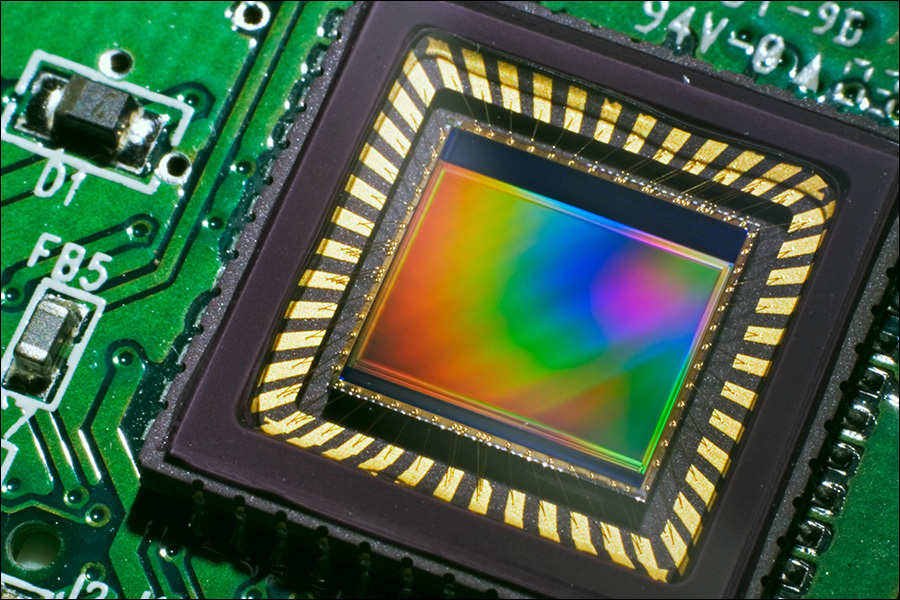
The image quality of the video camera largely depends on the photosensitive sensor (matrix) used in it. After all, put at least the best processor for video digitization – if a bad image is received on the matrix, it will not be good anymore. I will try to explain popularly what should be paid attention to the characteristics of the sensor of the CCTV camera, so that later it would not be painfully painful when looking at the image …
Matrix Type
You will find information that CCD (CCD, charge-coupled device) and CMOS (CMOS, complementary structure of metal-oxide-semiconductor) light-sensitive matrices are used in CCTV cameras. Forget it! For a long time there was only CMOS, only hardcore.
CCD matrix, with all their advantages (better photosensitivity and color rendering, less noise) – are practically not used in video surveillance. Because the principle of their action the CCD – sequential reading of the charge on the cells – too slow to meet the demands of today’s fastest high-definition camcorders. Well, the most important thing CCD is more expensive in production, and in the conditions of a modern highly competitive environment, every kopeck has arrived on the account. That’s why all the key manufacturers have focused on the issue is a CMOS sensor.
remains to producers, among other things, not so much. The largest, as of the beginning of 2017, are the companies: ON Semiconductor Corporation (at one time absorbed the well-known profile company Aptina), Omnivision Technologies Inc., Samsung Electronics and Sony Corporation. In addition, the matrix for own needs is produced, for example, by Canon, Hikvision.
Chinese, second-tier chipmakers like SOI (Silicon Optronics, Inc.) are trying to create competition for old brands, and others. It is difficult to say whether the young shoots will survive when is saturated and becomes too closely on the market CMOS sensors. But in any case, the appearance of new players and the aggravation of the struggle are not ruled out in this segment, since it is not too difficult to set up the production of CMOS sensors.
How are matrixes of digital cameras made
Leadership of CMOS
CMOS technology involves placing electronic components (capacitors, transistors) directly in each pixel of the photosensitive matrix.
The structure of the pixel and CMOS matrix
This reduces the useful area of the photosensitive element and reduces the sensitivity, plus the active elements increase the level of the matrix’s own noise. But the technology allows conversion charge the photosensitive member into an electrical signal directly in the matrix and is much faster to generate a digital image signal, which is critical for video cameras. That’s why CMOS is better suited for CCTV cameras where fast frame switching is required.
Principle of operation CCD and CMOS matrices
Plus, the ability to randomly read cells CMOS matrix allows you to literally “on the fly” to change the quality and bitrate of the resulting video, which is impossible for CCD. And the power consumption of CMOS solutions is lower, which is also important for compact surveillance cameras.
Let there be color
To get a color image, the matrix decomposes the light flux into the color components: red, Green and blue. For this purpose, appropriate light filters are used. Different manufacturers vary the location and the number of photosensitive elements of different colors, but the essence of this does not change.
The principle of image formation on a photosensitive matrix:
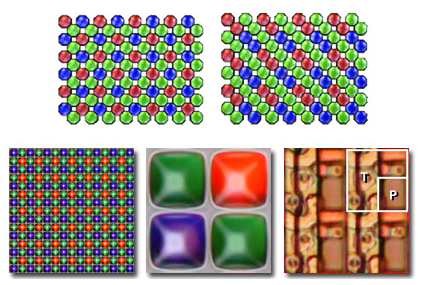
P – photosensitive element
T-electronic components
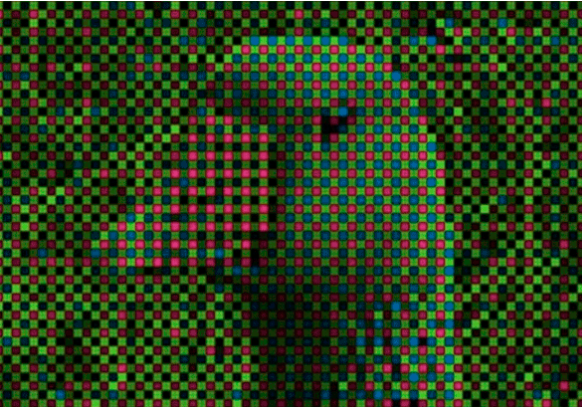
How the CMOS camera sensor works and can be viewed on this video from Canon:
CMOS matrices of all manufacturers are based on the above general principles, differing only in details of implementation on silicon. For example, in pursuit of cheapness and super-profits, chipmakers try to produce matrices as small as possible. Payment for this is inevitable …
Why large is good
The size (or in other words the format) of the matrix is usually measured diagonally in inches and indicated as a fraction, for example 1 / 4 “, 1/3”, 2/3 “, 1/2 inch, etc.
The first rule for choosing the best matrix is quite simple: with the same number of pixels (resolution), the larger the physical dimensions of the sensor – the better. at higher matrix larger pixels, which means it captures more light. The pixels are larger matrix are less crowded, and therefore less impact in And a lower level of parasitic noise, which directly affects the quality of the resulting image.Finally, a larger matrix allows to obtain large viewing angles when using a lens with the same focal length!
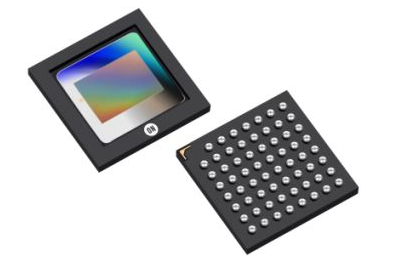
Light-sensitive matrix manufactured by ON Semicondactor for security cameras
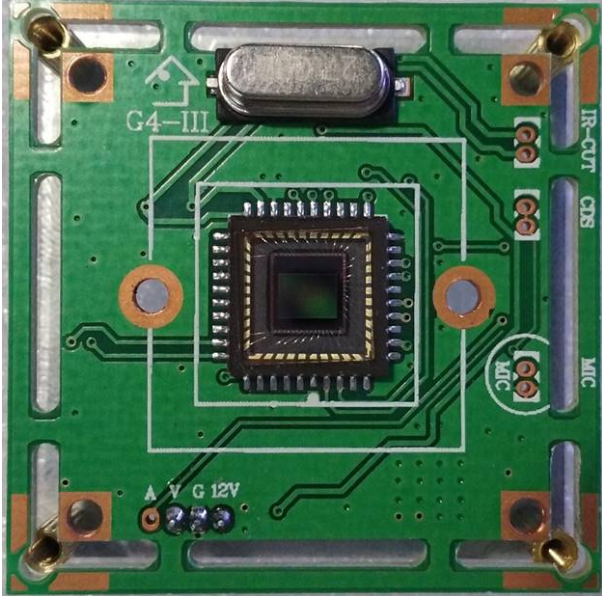
Light-sensitive matrix mounted on the video camera board
Alas, large format Matrix in mass cameras now nical not used due to the high cost and the matrices themselves, and lenses for them, that should have larger lenses and therefore the size and cost. To date, the cameras are installed mainly matrix size 1/2 “- 1/4” (this is the tiniest). When choosing a camera, you need to clearly understand that buying an ultra-cheap model with a 1/4 “SOI matrix and a tiny lens with dubious transparency plastic lenses, you will not be able to create an acceptable quality video control system on which it is possible to distinguish small details of the recorded events, especially When shooting in low light conditions.
Choosing the same camera with a Sony matrix of a size 1 / 2.8 “you a priori get a much better result for video quality, a camera with such a matrix is already quite possible to use In a professional video surveillance system. And the sensitivity of such a camera will certainly be higher, which will allow better shooting in low light conditions: in bad weather, at dusk, in a semi-dark room, etc. With increasing resolution at the same matrix size, the photosensitivity drops, and this must also be taken into account when selecting. For a camera installed in a dark gateway at the back door, it makes sense to choose a matrix with a lower resolution and higher sensitivity than an ultra-high resolution camera with a low sensitivity of the matrix on which nothing can be clearly discerned due to noise
Photosensitivity
The sensitivity of the matrix determines the possibility of its operation in conditions of weak ambient illumination. From the point of view of physics, this looks quite trite: the less light energy is sufficient to produce an image by a matrix, the higher its photosensitivity. But! Let’s be frank, chasing the high sensitivity is not particularly worth it. The fact is that modern CCTV cameras safely go into “day / night” modes, when lighting decreases, transferring the matrix to a black and white image with a higher sensitivity. Plus, the automatic inclusion of infrared illumination gives the camera the ability to shoot perfectly even in total darkness. For example, in a closed room without windows and with the lights off, when there is no question of the level of any external illumination. Sensitivity remains critical for cameras deprived of IR illumination, but use such in modern video surveillance – almost mauva. Although case models without illumination are still sold, of course. Comparison of matrices from different manufacturers
In general, the rule is this: the higher the illumination , The better the matrix and, accordingly, the camera. Therefore, it is not recommended to place cameras in semi-dark alleys, even if they have good sensitivity. Keep in mind that the camera matrix specification usually indicates a minimum level of illumination, when you can fix at least some image. But no one promises that this image will at least be of acceptable quality! It will be disgusting in 100% of cases, it will hardly be possible to disassemble anything. To achieve at least a satisfactory result, it is recommended to shoot at least with illumination at least 10-20 times higher than the minimum permissible for the matrix.
Manufacturers came up with a number of technical solutions to improve the sensitivity of CMOS matrices and reduce the loss of light in the process Fixation of the image. For this, one principle is basically used: to render the light-sensitive element as close as possible to the microlens of the matrix collecting light. First, Sony proposed its Exmor technology, which shortened the path of light in the matrix:
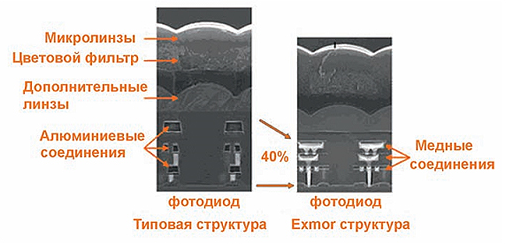
Then, progressive producers went amicably at using back-light matrices that not only reduced the path of light through the matrix , But also make the useful area of the photosensitive layer larger by placing it above other electronic elements in the cell:
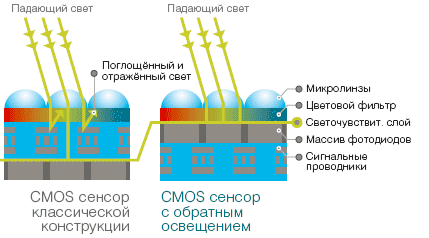
Backlight technology gives the camera maximum sensitivity. Hence the conclusion – “ceteris paribus” better acquire the camera array is used with feedback flare than without it
To improve the image in poor lighting conditions for slabochuvstvitelnyh cheap matrix camera makers can use various contrivances.. For example, a “slow shutter” mode, and to put it simply – a slow shutter mode. However, the “smearing” of the contours of moving objects already at the stage of fixation of the image by the matrix in this mode does not allow us to speak about a more or less high-quality video, so this approach is completely unacceptable in surveillance video, where details are important.
A certain breakthrough in image quality Starlight is the emergence of technology, first introduced in the Bosch cameras in 2012. This technology, thanks to a combination of a huge photosensitivity matrix (about 0.0001 – 0.001 lux) and very effective noise reduction technology, allowed to obtain a very high-quality color image from video cameras in low light conditions and even at night.
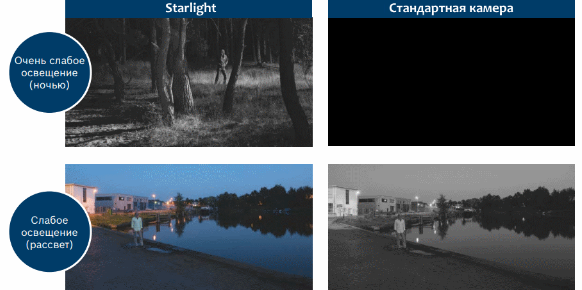
While the traditional method of overcoming the low light – the use of infrared illumination – makes it possible to obtain a clear picture only in monochrome (black and white) cameras with Starlight technology allows to get the color rtinku, are much more informative. In particular, in case of low illumination, a video surveillance system with Starlight technology will be able to easily distinguish between the colors of cars, clothes and other important signs.
Here is a demonstration of Starlight technology in action:








